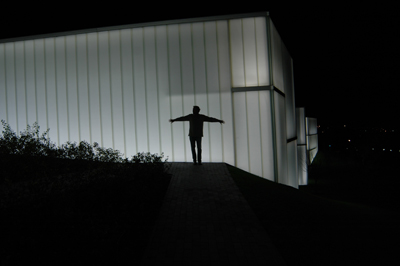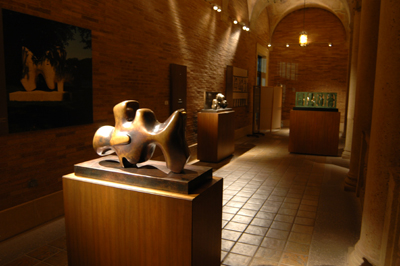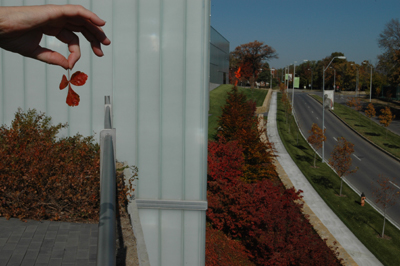Visiting Nelson-Atkins Art Museum
Translucent Walls and Steam

KANSAS CITY, MO — In a beautiful meditative space, sitting on black clean modern armless chairs eating Tapas — the cuisine culture of the day — listening to the enthusiastic server who sounded a tiny bit like Sarah Palin, I’m looking out a wall-length glass to a giant lawn dart two times my size.
A yellow school bus drives away from in front of the classic American public building which sits on one side of a rectangular reflecting pond — me, 90 degrees away reflecting on it — as the lights come on at the top of the 50-foot tall columns around the entrance dramatizing this 1930s building’s three dimensionality. Three-D clouds fill in the background of this painting beyond the glass wall in the Nelson-Atkins Art Museum Cafe. High white ones rolling off to the west to bed — as sunset always seems to us although we know better from physics. Some few pink ones are already behind the residential, low commercial skyline, tucked in.

We went into the old, classic building of the museum and looked at classical Western paintings organized educationally by date. We were in the mood to see a masterpiece. We breezed through their Asian art collection to get to see a collection of Henry Moore maquettes: miniature Henry Moore museum, and then spend some more time looking for a masterpiece. We finally found the museum’s Caravaggio. The painter painted boldly dramatic blacker blacks and whiter whites than the painters hung near him, and included no unnecessary frills, unlike the baroque guys who followed him. Okay, we learned something new.
After this search, the lights had come on and the new addition, by architect Steven Holl, glowed white in the black night. We walked around it, along a similar path we’d taken inside, except the path was in grass. The museum is open until 9 p.m. on Thursday and Friday nights. The new galleries in this addition are half buried in the ground and the exterior walls are made of a translucent material. We walked over and around the galleries and saw people throwing Frisbees, practicing martial arts, taking silhouette photos of themselves against the illuminated walls.
Inside, these galleries contain the modern art collection, and were also organized by periods. Someone at the museum has collected a nice group of Abstract Expressionist work — one of each: Rothko, deKooning, Reinhart, Gottleib, Gorky, Pollack, Franz Kline and two nice David Smith sculptures — and a room of pop art, another of minimalism, and one that is very diverse – undefined post modernism.
I wanted to like the temporary exhibit in the Hallmark Card Company’s galleries by the couple named Robert and Shana Parke-Harrison. Photographs (or photograveurs) of the Everyman in settings that were meant to prove the proverb of the title, over staged and sterile. These images were so sterile the artists had to print them in black and white to give them some warmth, said my companion. A little too close to advertising. Some company could use the series to promote business travel. Man wearing a suit overcoming things. Okay, if you’re going to be in the photograph you have to have a costume. He had to wear the suit. There is not an edginess or depth that makes me ask myself more. The work doesn’t reveal much about the place.
The new color photos were more interesting. One, the infinite glow of snow interrupted by a line of trash and one tree that made it a landscape, my companion complained. I thought the Everyman was in Anyplace and that was fitting. The photographs were transferred and etched onto a metal plate, inked in warm black, hand rubbed off and printed like fine art print, not offset or photo printed. Thus, they were photograveurs not photographs. The point of building very elaborate things to photograph seemed to be to explained in the titles: raking up a huge pile of trash was called Harvest.

The current exhibition in the main, changing gallery was art from the age of steam locomotives. 1860 to 1960. Kansas City was created by the railroads and it was a easy show to like, nothing that had to be explained. And if you needed explanation, there was a video when you walked in that said it all. There is no need to say more.
I’m still thinking however, about the odd photograveurs.
Terry Talty was an Art Tourist at the Nelson Atkins Museum of Art in October of 2008.

